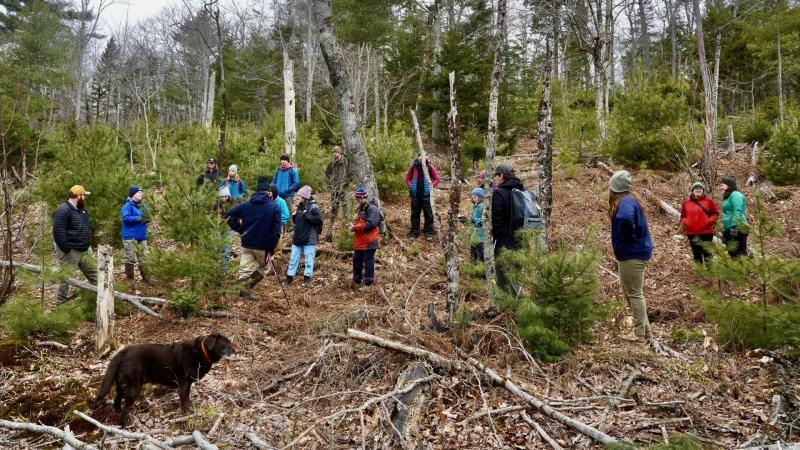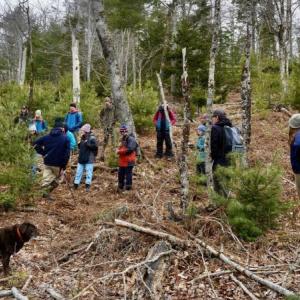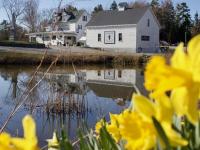Some Maine landowners see a future in ecological forest management
Robert Seymour looked approvingly around him at the mix of trees — white pines, sugar maples, white ashes and a few up-and-coming hemlocks — in an open, pleasant forest grove near Sebec. “We did things backwards here,” he said. “We took out trees but left saw timber.”
Seymour was standing with his fellow University of Maine forestry professor and wife Jessica Leahy in a grove in Wicopy Woods, a 350-acre forest they own and manage using ecological forestry practices, which differ significantly from conventional commercial timbering practices.
The two bought their first part of the land in 2015 from a couple who had managed it since 1968 using early sustainable forestry techniques. In 2017 they undertook a major harvest in this section, selectively thinning groves to benefit the trees left standing. They created different sized gaps in the canopy, mimicking a natural forest. The remaining trees grew rapidly in the increased sunlight. Downed logs and large tree snags were left as nutrient sources and wildlife habitat. In places they planted red spruce, white pine and red oak.
Now the tree mix within these woods contains a high percentage of commercially valuable species, with surprisingly little balsam fir — the tree most susceptible to cyclical attack by spruce budworms.
Leahy and Seymour have selected older “legacy trees” to be left standing, even to collapse — a financial loss but a long-term investment in the health of the forest. The goal is to manage their holdings in a way that both makes money and supports natural forest dynamics. Their approach, Seymour said, contradicts the prevailing idea that there’s an “unbridgeable gap between intact nature and wood production.”
“Industry is going to make things simple,” he said: Grow trees, cut them, grow them back, often leaving forests with little diversity. A more careful, habitat-sustaining approach to timbering can be just as lucrative, the two insist, and often more so.
Variations of Seymour’s and Leahy’s approach — sustainable forestry, exemplary forestry — employ slightly different techniques. Foresters argue the pros and cons of each model, but the overall goal is the same: Timber harvests generate profits; woodlands remain healthy.
Such approaches are more labor intensive and can be slower to produce income than traditional timbering practices. Even so, their earnings can be substantial — sometimes greater — and they tap into a natural, regenerative loop.
Trees are harvested one year; more are ready for harvest a few years later. In stands that are heavily cut with traditional timbering methods, regeneration requires 40 to 60 years or more.
Triad Forestry
Bob Seymour has promoted an ecological approach to forestry for more than three decades. In 1991 he and conservation biologist Malcolm Hunter, also of the University of Maine at Orono, gave a presentation at a national convention about a new model they called Triad Forestry.
It was a time, Seymour remembered, when forestry issues were particularly charged, in part because of growing concern about climate change. “Foresters tend to want to manage every acre,” he said. The profession was wrestling with the concept of what was then called New Forestry, with its more hands-off approach.
In the Triad model, forest lands are managed using three different timbering strategies. Some are logged commercially — business as usual, including heavy cutting and the creation of tree plantations. Others are set aside as natural reserves.
The final portion is logged but managed with careful selective harvesting that maintains natural forest habitat: ecological forestry or a similar model. The amount of land managed using each approach depends on the forest landscape and exposure, its soils and other factors.
The Triad Model was hailed by many foresters as a solution to the conundrum of providing an ample supply of timber while preserving natural habitat.
Canada embraced it beginning in 2003, starting with a 2.2 million acre tract in Quebec. It has since become a key strategy for managing government-owned forestlands in Nova Scotia.
But the model’s use in the United States has been limited. In the Pacific Northwest, one of the few places where it was tested, some of the “reserve forests” were actually high altitude groves with poor trees and marginal habitat, Seymour said.
Also, to Seymour’s and Hunter’s surprise, landowners were slow to embrace the ecological harvesting component.
“People just couldn’t seem to get their minds around it,” Seymour said. Even so, the Triad Model heavily influenced the development of current ecological forestry techniques.
Ecological timbering techniques
With its high proportion of privately owned forests, Maine differs markedly from forested states that have large federal holdings. Care of woodlands here is largely left to individual land owners.
Foresters describe the New England landscape as having four types of woodlands: natural areas, production forests, ecologically managed forests, and unmanaged forests. Many of the unmanaged tracts belong to landowners with less than 100 acres. The Maine Woodland Owners, a trade group, estimates that the state has 86,000 owners who each hold from a few acres of forest land to a few thousand.
The Forest Stewardship Council, a nonprofit organization that certifies woodlands as managed sustainably, defines responsible forestry as conserving vulnerable natural habitats, protecting rivers and streams, largely by minimizing erosion from timber cutting and roads, and protecting at-risk species and community rights, including those of indigenous communities.
A second group, the Sustainable Forestry Initiative, also certifies timberlands as producing sustainably grown timber using similar standards.
Although it’s difficult to gauge just how many, thousands of acres owned by nonprofit organizations in Maine are managed using timbering techniques that often go farther than required by certification programs. These include The Nature Conservancy, with significant holdings along the St. John River, 80,000 acres of which is held in a forest reserve.
TNC and other nonprofit groups have conserved more than 72 miles along the river and in its adjacent forests. Hard-cut forests within the Appalachian Mountain Club’s 100-mile wilderness are gradually being restored using ecological forestry practices. Maine’s Bureau of Public Parks and Lands also manages its holdings using sustainable forestry principles.
The New England Forestry Foundation has developed a model it calls Exemplary Forestry, which strives to balance the conditions in individual forest tracts with those of the surrounding landscape, filling gaps in habitat needs for plants and wildlife while producing high-quality timber. The goal is to have a healthy mix of land uses, as well as a diversity of tree species and sizes.
Needed markets for low-value timber
When forests are heavily cut and left untended, they often grow back in single-aged, crowded stands. Examples of such groves abound along Maine’s roadways, wherever forests were cleared and left alone. Skinny pole trees crowd together, leaving scant room for anything else.
Trees in the most crowded groves can’t develop the crowns or root mass needed to hold them firm, said Alec Giffen, senior forest and policy fellow with the New England Forestry Foundation. Thinning such groves is essential, but it’s taxing work and not cheap.
“For the average landowner, you don’t make enough money from it to be worth it,” Giffen said. This is especially true since the decline of the state’s pulp and paper industry drastically reduced demand for such low value timber.
To open new markets for wood cut from crowded stands, NEFF has championed the use of mass timber, in which small pieces of wood are glued together in a process that manufactures beams strong enough to support loads usually handled by concrete and steel. Cross laminated timber, or CLT, is built from a similar process.
So far, though, no assembly facilities for mass wood beams have been built in New England. Australia and Latvia can assemble the beams more cheaply, Giffen said. Also, all-wood construction can be a hard sell, because wood burns. “There’s a reason we don’t have cities going up in flames anymore,” one forester noted.
Giffen counters that mass timber and CLT beams aren’t fire hazards. Big pieces of wood may smolder, he said, but “they don’t continue to burn. It’s the small pieces and other components” that pose the danger. Industry studies confirm this.
Standard Biocarbon, a new company operating in Enfield, uses low value timber to manufacture biochar, a porous, charcoal-like wood-based fertilizer. It has been used in South America by indigenous tribes for generations, Giffen noted, and can cleanse soils of toxic materials, including PFAS. The company began making biochar in its Maine facility in 2022 and is ramping up production. Wood chips are converted to a granular material in a heated, oxygen-starved chamber.
For a few years Maine had a developing woody biomass industry — a viable market for low-value wood — with electricity generating plants in West Enfield and Jonesboro. Both plants closed in 2016, citing low prices for the energy they produced.
“Energy with zero carbon emissions, no oil or gas — exactly what we need more of,” Giffen said. “But it’s hard to compete with oil.”
Bates College is heated with a biomass product, he noted. Other new markets may be developing. TimberHP, a firm that produces wood fiber insulation from low-value wood, including chips of softwood from saw mills and timbering detritus like branches, opened a plant in Madison, Maine, and was featured in the state’s 2024 updated climate action plan, Maine Won’t Wait.
But in late March the company filed a Chapter 11 reorganization plan in bankruptcy court, saying it had run into unexpected delays and additional costs while retooling the Madison paper mill. Owners say the plant will continue to operate.
In time more markets may develop in Maine for other products made from low-value trees: in addition to biochar and mass timber, a substance made from ultra-refined pulp can be used as an additive to strengthen plastic, Giffen notes.
Developing those markets here and elsewhere will take time, though, while small trees continue to choke many of Maine’s forests.
This story was originally published by The Maine Monitor, a nonprofit civic news organization. To get regular coverage from The Monitor, sign up for a free Monitor newsletter here.
























